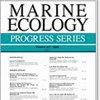From fringe to basin: unravelling the survival strategies of Calanus hyperboreus and C. glacialis in the Arctic Ocean
IF 2.1
3区 环境科学与生态学
Q2 ECOLOGY
引用次数: 0
Abstract
ABSTRACT: The large calanoids Calanus hyperboreus and C. glacialis dominate the zooplankton biomass in the central Arctic Ocean (CAO), but the absence of early life stages has raised speculation whether they complete their life cycle there, or whether they represent expatriates advected from adjacent regions. Our study, conducted across 2 transects of the CAO during fall 2011, focused on the distribution, stage composition, dry weight, individual lipid content, and egg production of these species. Although reproductive activity and early developmental stages were observed only on the fringes of the deep basins, late-stage copepodite and adult female abundances remained steady across the study area for C. glacialis and increased away from the shelves for C. hyperboreus. We found no decline in lipid content or dry weight in adult C. glacialis away from productive regions and only a minor reduction in adult C. hyperboreus. However, the lipid content and dry weight in C5 copepodites significantly decreased away from the shelf break, particularly in C. hyperboreus. This suggests that although early life stages struggle to survive in the resource-limited conditions of the deep CAO and even subadults remain vulnerable to starvation, adults have the resilience to survive long enough to be eventually transported by ocean currents to more favourable regions for reproduction. As such, we suggest that both species of Calanus are neither ‘residents’ nor ‘expatriates’ in the Arctic basins, but rather ontogenetic migrants that take advantage of different habitats within the Arctic Ocean to maximise their survival and reproductive success.从边缘到盆地:揭示北冰洋钙华鱼和冰川钙华鱼的生存策略
摘要:大型钙钛矿物种钙钛矿(Calanus hyperboreus)和冰川钙钛矿(C. glacialis)在北冰洋(CAO)中部的浮游动物生物量中占主导地位,但其早期生命阶段的缺失引起了人们的猜测,即它们是否在那里完成了生命周期,还是代表了从邻近地区移入的外来物种。我们的研究于 2011 年秋季在北冰洋中部的两个横断面上进行,重点研究了这些物种的分布、阶段组成、干重、个体脂质含量和产卵量。虽然仅在深海盆地的边缘观察到了繁殖活动和早期发育阶段,但在整个研究区域内,冰川鳕晚期桡足类和成年雌性的数量保持稳定,而在远离陆架的地方,冰川鳕的数量则有所增加。我们发现,在远离丰产区的地方,冰川栉水母成体的脂质含量和干重都没有下降,冰川栉水母成体的脂质含量和干重仅略有下降。然而,在远离陆架断裂带的地方,C5桡足类的脂质含量和干重显著下降,尤其是亢波鱼。这表明,虽然早期生命阶段在CAO深海资源有限的条件下难以生存,甚至亚成体仍然容易受到饥饿的影响,但成体具有足够长的生存能力,最终被洋流带到更有利的区域进行繁殖。因此,我们认为这两种沧龙鱼既不是北冰洋盆地的 "居民",也不是 "侨民",而是利用北冰洋不同生境最大限度地提高其生存和繁殖成功率的本体移民。
本文章由计算机程序翻译,如有差异,请以英文原文为准。
求助全文
约1分钟内获得全文
求助全文
来源期刊

Marine Ecology Progress Series
环境科学-海洋学
CiteScore
5.30
自引率
8.00%
发文量
238
审稿时长
3 months
期刊介绍:
The leading journal in its field, MEPS covers all aspects of marine ecology, fundamental and applied. Topics covered include microbiology, botany, zoology, ecosystem research, biological oceanography, ecological aspects of fisheries and aquaculture, pollution, environmental protection, conservation, and resource management.
 求助内容:
求助内容: 应助结果提醒方式:
应助结果提醒方式:


